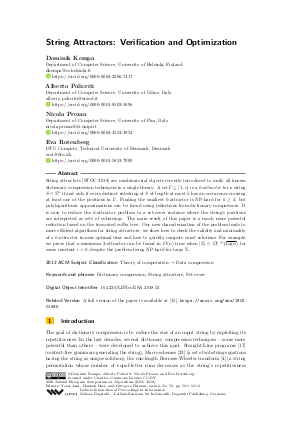String Attractors: Verification and Optimization
Authors
Dominik Kempa  ,
Alberto Policriti
,
Alberto Policriti  ,
Nicola Prezza
,
Nicola Prezza  ,
Eva Rotenberg
,
Eva Rotenberg 
-
Part of:
Volume:
26th Annual European Symposium on Algorithms (ESA 2018)
Part of: Series: Leibniz International Proceedings in Informatics (LIPIcs)
Part of: Conference: European Symposium on Algorithms (ESA) - License:
 Creative Commons Attribution 3.0 Unported license
Creative Commons Attribution 3.0 Unported license
- Publication Date: 2018-08-14
File

PDF
LIPIcs.ESA.2018.52.pdf
- Filesize: 445 kB
- 13 pages
Document Identifiers
Related Versions
Subject Classification
ACM Subject Classification
- Theory of computation → Data compression
Keywords
- Dictionary compression
- String attractors
- Set cover
Metrics
- Access Statistics
-
Total Accesses (updated on a weekly basis)
0Document
0Metadata
Abstract
String attractors [STOC 2018] are combinatorial objects recently introduced to unify all known dictionary compression techniques in a single theory. A set Gamma subseteq [1..n] is a k-attractor for a string S in Sigma^n if and only if every distinct substring of S of length at most k has an occurrence crossing at least one of the positions in Gamma. Finding the smallest k-attractor is NP-hard for k >= 3, but polylogarithmic approximations can be found using reductions from dictionary compressors. It is easy to reduce the k-attractor problem to a set-cover instance where the string's positions are interpreted as sets of substrings. The main result of this paper is a much more powerful reduction based on the truncated suffix tree. Our new characterization of the problem leads to more efficient algorithms for string attractors: we show how to check the validity and minimality of a k-attractor in near-optimal time and how to quickly compute exact solutions. For example, we prove that a minimum 3-attractor can be found in O(n) time when |Sigma| in O(sqrt[3+epsilon]{log n}) for some constant epsilon > 0, despite the problem being NP-hard for large Sigma.
Cite As Get BibTex
Dominik Kempa, Alberto Policriti, Nicola Prezza, and Eva Rotenberg. String Attractors: Verification and Optimization. In 26th Annual European Symposium on Algorithms (ESA 2018). Leibniz International Proceedings in Informatics (LIPIcs), Volume 112, pp. 52:1-52:13, Schloss Dagstuhl – Leibniz-Zentrum für Informatik (2018)
https://doi.org/10.4230/LIPIcs.ESA.2018.52
BibTex
@InProceedings{kempa_et_al:LIPIcs.ESA.2018.52,
author = {Kempa, Dominik and Policriti, Alberto and Prezza, Nicola and Rotenberg, Eva},
title = {{String Attractors: Verification and Optimization}},
booktitle = {26th Annual European Symposium on Algorithms (ESA 2018)},
pages = {52:1--52:13},
series = {Leibniz International Proceedings in Informatics (LIPIcs)},
ISBN = {978-3-95977-081-1},
ISSN = {1868-8969},
year = {2018},
volume = {112},
editor = {Azar, Yossi and Bast, Hannah and Herman, Grzegorz},
publisher = {Schloss Dagstuhl -- Leibniz-Zentrum f{\"u}r Informatik},
address = {Dagstuhl, Germany},
URL = {https://drops.dagstuhl.de/entities/document/10.4230/LIPIcs.ESA.2018.52},
URN = {urn:nbn:de:0030-drops-95153},
doi = {10.4230/LIPIcs.ESA.2018.52},
annote = {Keywords: Dictionary compression, String attractors, Set cover}
}
Author Details
References
-
Djamal Belazzougui. Linear time construction of compressed text indices in compact space. In Annual Symposium on Theory of Computing (STOC), pages 148-193. ACM, 2014.

-
Djamal Belazzougui, Fabio Cunial, Juha Kärkkäinen, and Veli Mäkinen. Linear-time string indexing and analysis in small space. arXiv preprint 1609.06378, 2016.

-
Anselm Blumer, Janet Blumer, David Haussler, Ross McConnell, and Andrzej Ehrenfeucht. Complete inverted files for efficient text retrieval and analysis. Journal of the ACM, 34(3):578-595, 1987.

-
Michael Burrows and David J. Wheeler. A block sorting lossless data compression algorithm. Technical Report 124, Digital Equipment Corporation, 1994.

-
David Clark. Compact Pat trees. PhD thesis, University of Waterloo, 1998.

-
Maxime Crochemore and Renaud Vérin. Direct construction of compact directed acyclic word graphs. In Combinatorial Pattern Matching (CPM), pages 116-129. Springer, 1997.

-
Martin Farach. Optimal suffix tree construction with large alphabets. In Annual Symposium on Foundations of Computer Science (FOCS), pages 137-143. IEEE, 1997.

-
Paolo Ferragina and Giovanni Manzini. Indexing compressed text. Journal of the ACM, 52(4):552-581, 2005.

-
Johannes Fischer and Volker Heun. Space-efficient preprocessing schemes for range minimum queries on static arrays. SIAM Journal on Computing, 40(2):465-492, 2011.

-
Roberto Grossi, Ankur Gupta, and Jeffrey Scott Vitter. High-order entropy-compressed text indexes. In Annual Symposium on Discrete Algorithms (SODA), pages 841-850. SIAM, 2003.

-
Roberto Grossi and Jeffrey Scott Vitter. Compressed suffix arrays and suffix trees with applications to text indexing and string matching. SIAM Journal on Computing, 35(2):378-407, 2005.

-
Prosenjit Gupta, Ravi Janardan, and Michiel Smid. Further results on generalized intersection searching problems: counting, reporting, and dynamization. Journal of Algorithms, 19(2):282-317, 1995.

-
Guy Joseph Jacobson. Succinct static data structures. PhD thesis, Carnegie Mellon University, 1988.

-
Juha Kärkkäinen, Peter Sanders, and Stefan Burkhardt. Linear work suffix array construction. Journal of the ACM, 53(6):918-936, 2006.

- Dominik Kempa, Alberto Policriti, Nicola Prezza, and Eva Rotenberg. String attractors: Verification and optimization. arXiv, 2018. URL: http://arxiv.org/abs/1803.01695.
-
Dominik Kempa and Nicola Prezza. At the roots of dictionary compression: String attractors. In Annual Symposium on Theory of Computing (STOC), pages 827-840. ACM, 2018.

-
John C. Kieffer and En-Hui Yang. Grammar-based codes: A new class of universal lossless source codes. IEEE Transactions on Information Theory, 46(3):737-754, 2000.

-
Udi Manber and Gene Myers. Suffix arrays: A new method for on-line string searches. SIAM Journal on Computing, 22(5):935-948, 1993.

-
Silvio Micali and Vijay V. Vazirani. An O(√|V|⋅ |E|) algorithm for finding maximum matching in general graphs. In Annual Symposium on Foundations of Computer Science (SFCS), pages 17-27. IEEE, 1980.

-
J. Ian Munro, Gonzalo Navarro, and Yakov Nekrich. Space-efficient construction of compressed indexes in deterministic linear time. In Annual Symposium on Discrete Algorithms (SODA), pages 408-424. SIAM, 2017.

-
Gonzalo Navarro. Wavelet trees for all. Journal of Discrete Algorithms, 25:2-20, 2014.

-
Gonzalo Navarro. Compact data structures: A practical approach. Cambridge University Press, 2016.

-
James A. Storer and Thomas G. Szymanski. Data compression via textual substitution. Journal of the ACM, 29(4):928-951, 1982.

-
Peter Weiner. Linear pattern matching algorithms. In Annual Symposium on Switching and Automata Theory (SWAT/FOCS), pages 1-11. IEEE, 1973.

